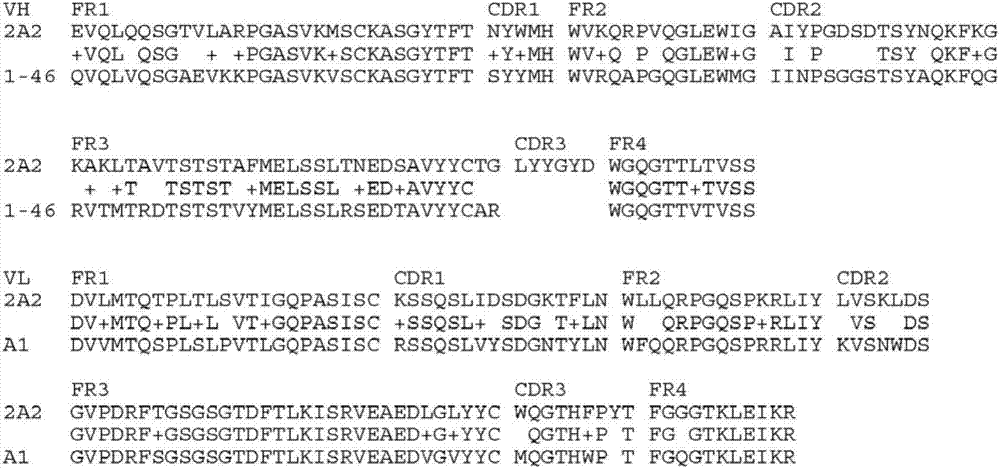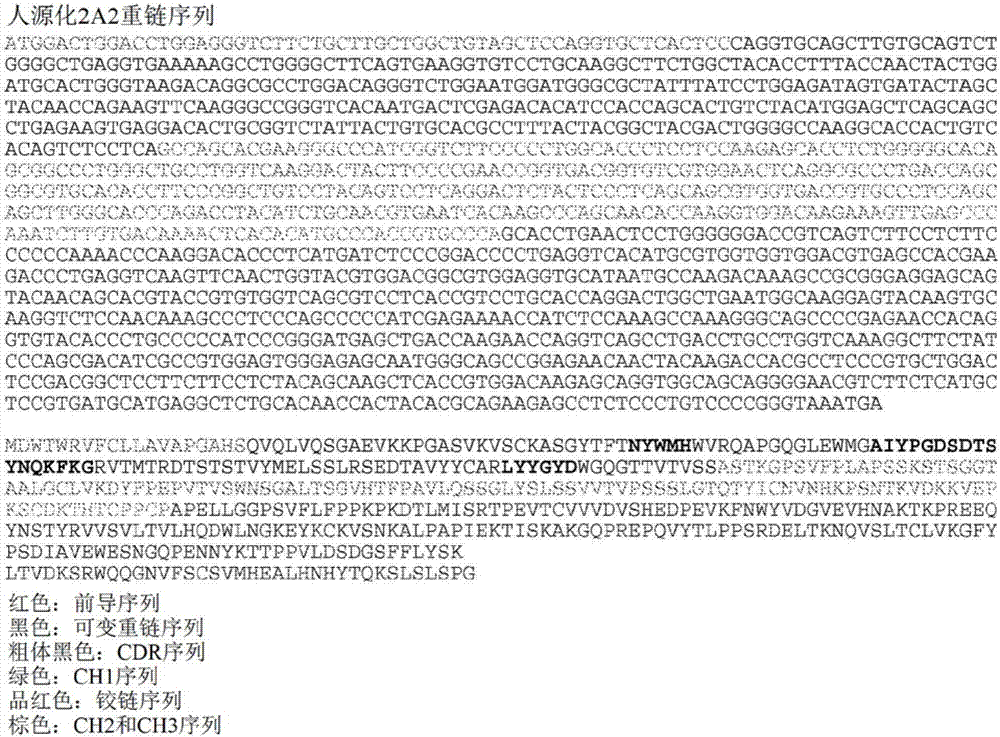Anti-ceramide antibodies
A ceramide, antibody technology, applied in the direction of antibodies, antitoxins, anti-receptor/cell surface antigen/cell surface determinant immunoglobulin, etc., can solve the problems of increasing the transplant failure rate and the overall survival rate is not improved.
- Summary
- Abstract
- Description
- Claims
- Application Information
AI Technical Summary
Problems solved by technology
Method used
Image
Examples
Embodiment 1
[0096] Example 1: 2A2 Ab humanization and product
[0097] Cloning of variable light and heavy chains of 2A2 from hybridomas
[0098] The 2A2 hybridoma cells were harvested by centrifugation and total RNA was extracted from the cells using an RNA purification kit. The total RNA was used for cDNA synthesis, and finally the V region gene of 2A2 was isolated using the primer set disclosed in the "Phage display manual". Figure 1A The variable heavy chain (VH) and light chain (VL) sequences of 2A2 are shown.
[0099] Humanization of the variable region of 2A2
[0100] Generally, rodent antibodies are immune to humans and cause extremely serious side effects, including HAMA (human anti-mouse antibody) reactions or anaphylactic shock. To solve this problem, antibody engineering has been used to humanize non-human antibodies. Therefore, the VL and VH of 2A2 were humanized using the CDR grafting method.
[0101] CDR transplantation is currently the most commonly used strategy for humanized...
Embodiment 2
[0110] Example 2: Production of additional anti-ceramide antibodies
[0111] A panel of monoclonal antibodies was generated for repeated administration studies in mice to study immunogenicity. Using antigen (ω-COOH C16-ceramide coupled with albumin), hybridomas were screened by ELISA to select anti-ceramide Mabs. The positive hits were screened for counting BSA and ω-COOH C16-dihydroceramide coupled with albumin. Then the biological test of Mabs (in vitro inhibition of Jurkat cell apoptosis, in vivo inhibition of radiation GI syndrome) was performed. The clones named 9H10, 9H11, 9A2, 7B10, 6B5 and 6C8 were selected for test selection, and all the in vitro activities except 9A2 were confirmed. As shown in Table 1, a group of clones preferentially bind to C16:0 carboxyceramide-BSA. Ag1 is C16:0 carboxyceramide-BSA coated @300ng / well, Ag2 is C16:0 dihydro-carboxyceramide-BSA coated @300ng / well, and Ag3 is free BSA (Sigma A6003) coated @300ng / hole.
[0112] Table 1-Anti-Ceramide ...
Embodiment 3
[0124] Example 3: Production of anti-ceramide SCFV
[0125] Based on the Mab efficacy data, the CDR of 6B5 (along with 2a2) was selected to be engineered as a single chain Fv. Two single-chain (sc) Fv constructs were engineered to express scFv and provide purified scFv for efficacy testing. 6B5scFv is easy to express and purify. For example, using Mabs, the in vitro inhibition of Jurkat cell apoptosis and the in vivo inhibition of radiation GI syndrome are used for the biological test of scFv. Figure 5 It was shown that 6B5IgG was protected from crypt death by the microcolony assay. Figure 7 Show that scFv inhibits jurkat cell apoptosis. Figure 8 It was shown that when administered 15 minutes before 15Gy exposure, 6B5scFv protects from GI crypt depletion in vivo. Picture 9 It was shown that when administered 24 hours after 15Gy exposure, 6B5scFv reduced in vivo GI crypt depletion in vivo.
[0126] Anti-ceramide scFv protects mice from lethal acute graft-versus-host disease ...
PUM
 Login to View More
Login to View More Abstract
Description
Claims
Application Information
 Login to View More
Login to View More - Generate Ideas
- Intellectual Property
- Life Sciences
- Materials
- Tech Scout
- Unparalleled Data Quality
- Higher Quality Content
- 60% Fewer Hallucinations
Browse by: Latest US Patents, China's latest patents, Technical Efficacy Thesaurus, Application Domain, Technology Topic, Popular Technical Reports.
© 2025 PatSnap. All rights reserved.Legal|Privacy policy|Modern Slavery Act Transparency Statement|Sitemap|About US| Contact US: help@patsnap.com



